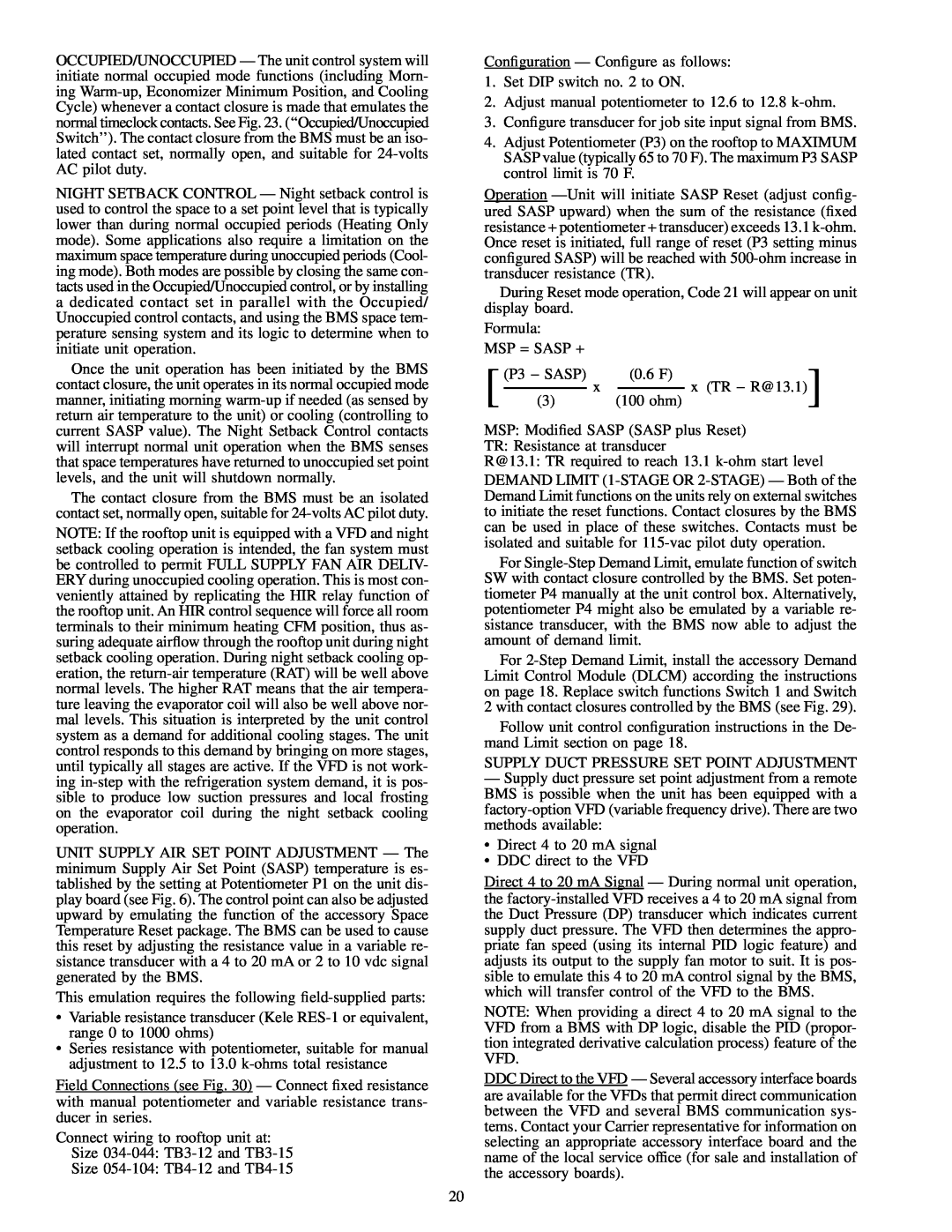OCCUPIED/UNOCCUPIED Ð The unit control system will initiate normal occupied mode functions (including Morn- ing
NIGHT SETBACK CONTROL Ð Night setback control is used to control the space to a set point level that is typically lower than during normal occupied periods (Heating Only mode). Some applications also require a limitation on the maximum space temperature during unoccupied periods (Cool- ing mode). Both modes are possible by closing the same con- tacts used in the Occupied/Unoccupied control, or by installing a dedicated contact set in parallel with the Occupied/ Unoccupied control contacts, and using the BMS space tem- perature sensing system and its logic to determine when to initiate unit operation.
Once the unit operation has been initiated by the BMS contact closure, the unit operates in its normal occupied mode manner, initiating morning
The contact closure from the BMS must be an isolated contact set, normally open, suitable for
NOTE: If the rooftop unit is equipped with a VFD and night setback cooling operation is intended, the fan system must be controlled to permit FULL SUPPLY FAN AIR DELIV- ERY during unoccupied cooling operation. This is most con- veniently attained by replicating the HIR relay function of the rooftop unit. An HIR control sequence will force all room terminals to their minimum heating CFM position, thus as- suring adequate air¯ow through the rooftop unit during night setback cooling operation. During night setback cooling op- eration, the
UNIT SUPPLY AIR SET POINT ADJUSTMENT Ð The minimum Supply Air Set Point (SASP) temperature is es- tablished by the setting at Potentiometer P1 on the unit dis- play board (see Fig. 6). The control point can also be adjusted upward by emulating the function of the accessory Space Temperature Reset package. The BMS can be used to cause this reset by adjusting the resistance value in a variable re- sistance transducer with a 4 to 20 mA or 2 to 10 vdc signal generated by the BMS.
This emulation requires the following ®eld-supplied parts:
·Variable resistance transducer (Kele
·Series resistance with potentiometer, suitable for manual adjustment to 12.5 to 13.0
Field Connections (see Fig. 30) Ð Connect ®xed resistance with manual potentiometer and variable resistance trans- ducer in series.
Connect wiring to rooftop unit at: Size
Con®guration Ð Con®gure as follows:
1.Set DIP switch no. 2 to ON.
2.Adjust manual potentiometer to 12.6 to 12.8
3.Con®gure transducer for job site input signal from BMS.
4.Adjust Potentiometer (P3) on the rooftop to MAXIMUM SASP value (typically 65 to 70 F). The maximum P3 SASP control limit is 70 F.
Operation ÐUnit will initiate SASP Reset (adjust con®g- ured SASP upward) when the sum of the resistance (®xed resistance + potentiometer + transducer) exceeds 13.1
During Reset mode operation, Code 21 will appear on unit display board.
Formula:
MSP = SASP +
[ | (P3 − SASP) | x |
| (0.6 F) | x (TR − R@13.1) ] |
(3) | (100 ohm) | ||||
MSP: Modi®ed SASP (SASP plus Reset)
TR: Resistance at transducer
R@13.1: TR required to reach 13.1
DEMAND LIMIT
For
For
Follow unit control con®guration instructions in the De- mand Limit section on page 18.
SUPPLY DUCT PRESSURE SET POINT ADJUSTMENT
ÐSupply duct pressure set point adjustment from a remote BMS is possible when the unit has been equipped with a
·Direct 4 to 20 mA signal
·DDC direct to the VFD
Direct 4 to 20 mA Signal Ð During normal unit operation, the
NOTE: When providing a direct 4 to 20 mA signal to the VFD from a BMS with DP logic, disable the PID (propor- tion integrated derivative calculation process) feature of the VFD.
DDC Direct to the VFD Ð Several accessory interface boards are available for the VFDs that permit direct communication between the VFD and several BMS communication sys- tems. Contact your Carrier representative for information on selecting an appropriate accessory interface board and the name of the local service office (for sale and installation of the accessory boards).
20
